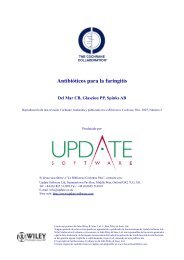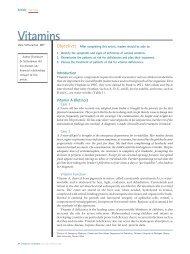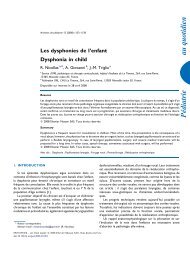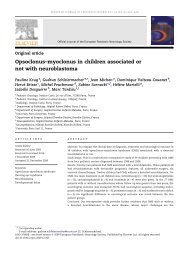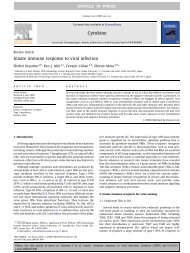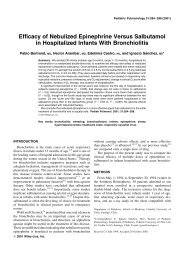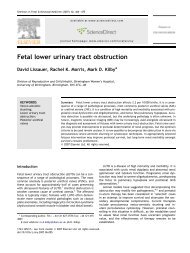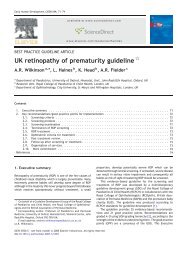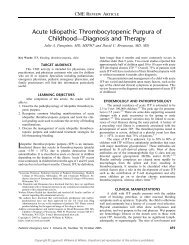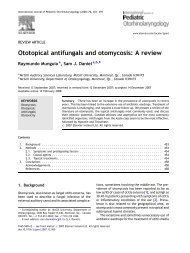Pertussis: a concise historical review including diagnosis ... - sepeap
Pertussis: a concise historical review including diagnosis ... - sepeap
Pertussis: a concise historical review including diagnosis ... - sepeap
You also want an ePaper? Increase the reach of your titles
YUMPU automatically turns print PDFs into web optimized ePapers that Google loves.
80 Reviews in Medical Microbiology 2005, Vol 16 No 3<br />
German) kinkhoste is found in a source from 1464.<br />
Dodonaeus (1517–1585) in his Cruijde boeck [8] (book of<br />
herbs) from 1554 already describes cures for the kieckhoest!<br />
De Baillou called it quinta, referring to Hippocrates [1].<br />
Coqueluche, the present name in French for whooping<br />
cough, was then the common name for influenza [9].<br />
Holmes [10] reports that pertussis was called chyne-cough<br />
in England as early as 1519. Cherry and Heininger [11]<br />
say it was called the kink (in Scottish synonymous with fit<br />
or paroxysm) and kindhoest (a Teutonic word meaning<br />
child’s cough) in the Middle Ages. Nils Rosén von<br />
Rosenstein [6] calls it in his book about paediatric diseases<br />
from 1798 Keichhussten. InaJAMA editorial [12] names<br />
such as tosse canina (dog’s bark, Italy), Wolfshusten (howling<br />
of wolves) and Eselshusten (braying of donkeys) (both<br />
from Germany), and chincough (boisterous laughter, Old<br />
English) are given. In Chinese it is called ‘‘cough of<br />
100 days’’ [13]. In Dutch it is called kinkhoest, coming<br />
from old names as kinkhôste, kichhoest, keichhusten, asvan<br />
Esso describes [14]. In the Dictionary of the Dutch<br />
Language (Woordenboek der Nederlandsche Taal) [15] the<br />
same names are given, and others as kie(c)khoest, kijkhoest,<br />
kikhoest. Also it refers to Dodonaeus (1517–1585) who<br />
called the disease kich,orkinchoest in a latter edition of his<br />
‘‘Cruydt-Boeck’’ from 1608 [16].<br />
Since in these old days there were no possibilities to prove<br />
the <strong>diagnosis</strong> we will never know whether all these<br />
diseases then were the same as our whooping cough that,<br />
as we know today, is caused by B. pertussis, or that they<br />
were pertussis-like syndromes, caused by one or more<br />
other pathogens [17–23].<br />
stage usually lasts 1–6 weeks, but may persist for up to<br />
10 weeks.<br />
Young infants (under 6 months of age) may not have the<br />
strength to have a whoop, but they do have paroxysms of<br />
coughing. The cough though may be absent and disease<br />
may then manifest with spells of apnoea [24].<br />
Although pertussis may occur at any age, most cases of<br />
serious disease and the majority of fatalities are observed<br />
in early infancy. The most important complications in<br />
the USA are hospitalization (72.2% in children younger<br />
than 6 months, 3.9% for those over 20 years of age),<br />
bronchopneumonia (17.3 versus 3.4%), seizures (2.1<br />
versus 0.5%), acute encephalopathy (0.5 versus 0.1%), the<br />
latter frequently resulting in death or lifelong brain<br />
damage, and death (0.5 versus 0) [25]. Heininger reported<br />
in proven pertussis patients in Germany an overall<br />
complication rate of 5.8%, pneumonia (29%) being the<br />
most frequent complication. In infants less than 6 months<br />
of age, the rate of complications was 23.8% [26].<br />
At the end of the catarrhal phase, a leukocytosis with an<br />
absolute and relative lymphocytosis frequently begins,<br />
reaching its peak at the height of the paroxysmal stage. At<br />
this time, the total blood leukocyte levels may resemble<br />
those of leukaemia ( 100 000/ml), with 60–80%<br />
lymphocytes.<br />
The convalescent phase, the last stage, lasting 1–3 weeks,<br />
is characterized by a gradual, continuous decline of the<br />
cough before the patient returns to normal. However,<br />
paroxysms often recur with subsequent respiratory<br />
infections for many months after the onset of pertussis.<br />
Fever is generally minimal throughout the course of<br />
pertussis.<br />
Clinical manifestations<br />
Clinical manifestations of whooping cough may show<br />
substantial variation, depending on previous vaccination,<br />
earlier infection with B. pertussis, age or the clinical<br />
condition of the patient. The clinical course is divided<br />
into three stages. After an incubation period of 5–10 days,<br />
with an upper limit of 21 days, illness begins with the<br />
catarrhal phase. This phase lasts 1–2 weeks and is usually<br />
characterized by low-grade fever, rhinorrhoea, and progressive<br />
cough.<br />
In the subsequent paroxysmal phase, lasting several<br />
weeks, B. pertussis causes severe and spasmodic cough<br />
episodes with a characteristic whoop, often with cyanosis<br />
and vomiting. The patient usually appears normal<br />
between attacks. Paroxysmal attacks occur more frequently<br />
at night, with an average of 15 attacks per 24 h.<br />
During the first 1 or 2 weeks of this stage the attacks<br />
increase in frequency, then remain at the same level for 2–<br />
3 weeks, and then gradually decrease. The paroxysmal<br />
Microbiology<br />
The genus Bordetella contains species of related bacteria<br />
with similar morphology, size, and staining reactions. To<br />
date there are eight species known of Bordetella:<br />
B. pertussis [27], B. parapertussis [28,29], B. bronchiseptica<br />
[30], B. avium [31] (formerly designated Alcaligenes<br />
faecalis), B. hinzii [32,33] (formerly designated A. faecalis<br />
type II), B. holmesii [34], B. trematum [35] and B. petrii<br />
[36]. Bordetella pertussis, B. parapertussis and B. bronchiseptica<br />
are genomically closely related. The first four are<br />
respiratory pathogens. Bordetella pertussis is an obligate<br />
human pathogen. Bordetella pertussis was long considered<br />
the sole agent of whooping cough. A mild, pertussis-like<br />
disease in humans may be caused by B. parapertussis and<br />
occasionally by B. bronchiseptica. Bordetella parapertussis<br />
appears both in humans and animals. The natural habitat<br />
of B. bronchiseptica is the respiratory tract of smaller animals<br />
such as rabbits, cats, and dogs. Human infections with




